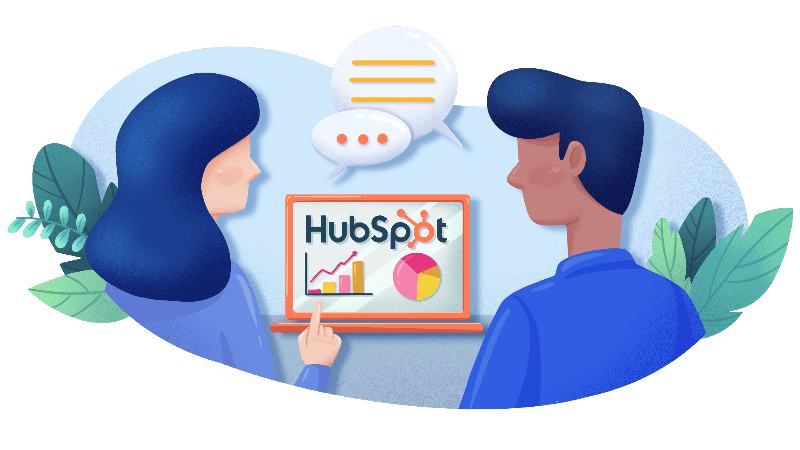Was sind HubSpot Playbooks, und wie kann ich sie verwenden?
In der Welt des effektiven Vertriebs und Marketings ist Konsistenz das A und O. Egal, ob Sie Leads pflegen, Geschäfte abschließen oder Kundensupport leisten, ein standardisierter Ansatz stellt sicher, dass Ihr Team mit höchster Effizienz arbeitet. Und genau hier kommen HubSpot Playbooks ins Spiel.

Mit diesem leistungsstarken Tool können Sie Schritt-für-Schritt-Anleitungen für gängige Vertriebs- und Marketingprozesse erstellen und gemeinsam nutzen. Mit Playbooks können Sie Ihr Team mit dem Wissen und den Ressourcen ausstatten, die es braucht, um kontinuierlich außergewöhnliche Ergebnisse zu erzielen.
Was sind HubSpot Playbooks?
Stellen Sie sich vor, Sie hätten ein zentrales Repository mit Best Practices, Vorlagen und Ressourcen, auf das Ihr Team bei Bedarf einfach zugreifen kann. Genau das bieten HubSpot Playbooks.
Playbooks in HubSpot sind interaktive Inhaltskarten, die an Kontakt-, Unternehmens-, Deal- und Ticket-Datensätze in Ihrem HubSpot CRM angehängt werden können. Auf Enterprise-Ebenen sind sie auch für benutzerdefinierte Objekte verfügbar. Sie sind ein zentrales Repository für Best Practices, Vorlagen und andere Ressourcen, die Ihr Team durch verschiedene Vertriebs- und Marketingszenarien führen.
HubSpot Playbooks sind nicht auf eine einzelne Funktion beschränkt. Stattdessen umfassen sie ein vielseitiges Spektrum an Anwendungen. Von der Erleichterung von Routineaufgaben in Vertriebsprozessen oder Vertriebsbesprechungen bis hin zur Orchestrierung komplexer Marketingkampagnen - die Erstellung eines Playbooks unterstützt Unternehmen aller Branchen. Außerdem können sie Ihnen die Pflege Ihrer CRM-Datenbank erleichtern.
Die wichtigsten Komponenten:
-
Auslöser: Auslösende Ereignisse, die das Playbook in Bewegung setzen. Die Auslöser können vielfältig sein und reichen von einem Lead, der eine bestimmte Phase erreicht, bis hin zu einer Kundeninteraktion auf Ihrer Website.
-
Aktionen: Die Reihe von Schritten und Aufgaben, die ausgeführt werden, sobald ein Auslöser aktiviert wird. Dazu kann das Versenden von E-Mails, das Aktualisieren von Kontaktdatensätzen, das Zuweisen von Aufgaben an Teammitglieder oder sogar das Einleiten von Folgeaktionen gehören.
-
Bedingungen: Anpassbare Kriterien, die festlegen, wann ein Playbook ausgeführt werden soll oder nicht. Bedingungen fügen eine Ebene der Spezifität hinzu und stellen sicher, dass Playbooks auf intelligente Weise auf verschiedene Szenarien reagieren.
-
Verzweigungslogik: Ein Entscheidungselement innerhalb des Playbooks, das den Workflow auf der Grundlage bestimmter Bedingungen oder Kriterien steuert. Dies gewährleistet einen personalisierten und zielgerichteten Ansatz in Ihren Marketingbemühungen.
Die Vorteile der Implementierung von HubSpot Playbooks sind zahlreich:
-
Standardisierte Prozesse: Beseitigen Sie Diskrepanzen in der Vorgehensweise und sorgen Sie für ein konsistentes Kundenerlebnis, indem Sie standardisierte Prozesse einrichten.
-
Gesteigerte Effizienz: Optimieren Sie Arbeitsabläufe und reduzieren Sie die Zeit, die Sie mit der Suche nach Informationen verbringen, durch schrittweise Anleitungen und leicht zugängliche Ressourcen.
-
Mühelose Einarbeitung: Bringen Sie neue Mitarbeiter schnell auf den neuesten Stand, indem Sie ihnen ein wertvolles Schulungsinstrument zur Verfügung stellen, das die Prozesse und bewährten Verfahren Ihres Teams beschreibt.
-
Konsistente Kundenerfahrung: Fördern Sie positive Markenbeziehungen, indem Sie sicherstellen, dass jede Kundeninteraktion professionell und konsistent gehandhabt wird.
-
Datengestützte Entscheidungsfindung: Treffen Sie fundierte Entscheidungen auf der Grundlage wertvoller Einblicke in die Teamleistung und Prozesseffizienz.
So verwenden Sie Playbooks in HubSpot
Nachdem Sie die Grundlagen von HubSpot Playbooks verstanden haben, ist es nun an der Zeit, ihre bemerkenswerte Vielseitigkeit zu erkunden. Ursprünglich als Tool zur Optimierung von Prozessen im Militär- oder Sportbereich konzipiert, hat sich das Playbook-Tool zu einem unverzichtbaren Hilfsmittel für verschiedene Facetten des Geschäftsbetriebs entwickelt.
Lead-Generierung
HubSpot Playbooks sind starke Katalysatoren für die Lead-Generierung und bieten einen systematischen Ansatz zur Identifizierung, Pflege und Umwandlung von Interessenten in geschätzte Kunden. Durch die Automatisierung der Lead-Bewertung, den Versand zielgerichteter E-Mails und die Auslösung personalisierter Follow-ups auf der Grundlage des Benutzerverhaltens ermöglichen diese Playbooks Ihrem Marketingteam, seine Bemühungen effizient zu optimieren.
Beispiel: Stellen Sie sich vor, ein potenzieller Lead lädt ein Whitepaper von Ihrer Website herunter. Mit HubSpot Playbooks kann eine automatisierte Sequenz ausgelöst werden, die eine Reihe von maßgeschneiderten E-Mails versendet und den Lead durch den Verkaufstrichter leitet.
Sales Enablement
Vertriebsteams können von der Integration von HubSpot Playbooks in ihre Arbeitsabläufe enorm profitieren. Playbooks erleichtern eine reibungslosere Kommunikation durch die Automatisierung von Routineaufgaben, so dass sich die Vertriebsmitarbeiter auf die wichtigsten Aktivitäten konzentrieren können. Von der Kontaktaufnahme bis zum Geschäftsabschluss sorgen diese Playbooks für einen kohärenten und strategischen Ansatz während des gesamten Vertriebszyklus.
Beispiel: Ein Playbook für den Vertrieb kann so gestaltet werden, dass Follow-up-E-Mails automatisiert, Anrufe geplant und der Status von Leads auf der Grundlage ihres Engagements aktualisiert werden, so dass sichergestellt ist, dass Vertriebsmitarbeiter immer zum richtigen Zeitpunkt und mit den relevantesten Informationen auf Leads zugehen.
32 % der Vertriebsteams berichten von einer gesteigerten Effizienz nach der Implementierung von HubSpot Playbooks.
Verbesserung des Kundendienstes
Über die Kundenakquise hinaus sind HubSpot Playbooks von zentraler Bedeutung für die Festigung von Kundenbeziehungen. Durch die Automatisierung von Antworten auf häufige Anfragen, die Initiierung von Umfragen zum Kundenfeedback und die proaktive Behebung potenzieller Probleme tragen diese Playbooks zu einer verbesserten Kundenserviceerfahrung bei.
Beispiel: Wenn ein Kunde ein Support-Ticket einreicht, kann ein Playbook ausgelöst werden, um die Anfrage zu bestätigen, erste Schritte zur Fehlerbehebung bereitzustellen und das Ticket nahtlos dem entsprechenden Support-Agenten zuzuweisen, um einen schnellen und organisierten Lösungsprozess zu gewährleisten.
45 % der Marketingteams berichten über eine verbesserte Kundenzufriedenheit nach der Einführung von HubSpot Playbooks.
Onboarding-Prozesse
Eine oft übersehene Anwendung von HubSpot Playbooks ist der Bereich Onboarding. Ganz gleich, ob Sie neue Kunden einführen oder neue Mitarbeiter durch die Einarbeitung begleiten, Playbooks können so angepasst werden, dass sie eine nahtlose und personalisierte Erfahrung bieten. Automatisierte Begrüßungs-E-Mails, Anleitungen und geplante Check-Ins können zur Verbesserung der Onboarding-Reise orchestriert werden.
Beispiel: Für ein SaaS-Unternehmen können Playbooks verwendet werden, um neue Benutzer durch den Onboarding-Prozess zu führen, indem automatisierte Anleitungen gesendet und in strategischen Abständen Feedback eingeholt werden, um einen reibungslosen Übergang zur Nutzung des Produkts zu gewährleisten.
Mitarbeiterschulung und -entwicklung
Intern können HubSpot Playbooks zur Erleichterung von Initiativen zur Mitarbeiterschulung und -entwicklung eingesetzt werden. Durch die Automatisierung der Bereitstellung von Schulungsmaterialien, Quizfragen und Leistungsbewertungen tragen Playbooks zu einem effizienteren und ansprechenderen Schulungsprozess bei.
Beispiel: Für das Onboarding neuer Mitarbeiter kann ein HR-Playbook erstellt werden, das die Verteilung von Schulungsmodulen, die Planung von Mentorensitzungen und die Messung der Mitarbeiterzufriedenheit während des Onboarding-Prozesses automatisiert.
Wie man Playbooks erstellt
Der Prozess der Erstellung von HubSpot Playbooks ist unkompliziert und kann von jedem Team anhand dieser Schritte effektiv umgesetzt werden:
1. Erstellen Sie ein neues Playbook
-
-
Navigieren Sie in Ihrem HubSpot-Konto zum Abschnitt Sales > Playbooks.
-
Klicken Sie auf die Schaltfläche "Playbook erstellen" in der oberen rechten Ecke.
-
Wählen Sie die Art des Playbooks aus, das Sie erstellen möchten: Vertrieb oder Service. Sie können eine Vorlage auswählen oder von Grund auf neu beginnen.
-
2. Benennen Sie Ihr Playbook
-
-
Klicken Sie auf das Bleistiftsymbol oben auf der Seite und geben Sie einen prägnanten und beschreibenden Namen für Ihr Playbook ein.
-
Dieser Name sollte den Zweck des Playbooks und das Szenario, das es behandelt, angeben.
-
Klicken Sie auf "Playbook erstellen".
-
3. Spielbuchinhalt hinzufügen
-
-
Beginnen Sie mit dem Hinzufügen von Inhalten zu Ihrem Spielbuch mithilfe der Inhaltsblöcke.
-
Wählen Sie aus einer Vielzahl von Inhaltsblöcken, darunter:
-
Textblöcke: Fügen Sie Texterklärungen, Anweisungen oder Notizen hinzu.
-
Videos: Betten Sie YouTube- oder Vimeo-Videos als visuelle Anleitung ein.
-
Bilder: Fügen Sie Bilder ein, um das Verständnis zu verbessern und visuelle Beispiele zu liefern.
-
Links: Fügen Sie Links zu relevanten Ressourcen wie Vorlagen, Leitfäden oder Dokumentationen hinzu.
-
Emails: Fügen Sie Beispiel-E-Mail-Vorlagen für bestimmte Szenarien ein.
-
Skripte: Stellen Sie Verkaufsskripte für effektive Kundeninteraktionen zur Verfügung.
-
Fragenblöcke: Binden Sie Ihr Team mit interaktiven Fragen und Quizfragen ein.
-
-
4. Strukturieren Sie Ihr Spielbuch
-
-
Unterteilen Sie Ihr Spielbuch in logische Abschnitte mit Hilfe von Steps.
-
Jeder Schritt sollte eine bestimmte Aktion oder Phase innerhalb des Gesamtszenarios darstellen.
-
Verwenden Sie beschreibende Schritttitel und klare Anweisungen für jeden Schritt.
-
5. Fügen Sie Vorlagen und Ressourcen hinzu
-
Verknüpfen Sie relevante Vorlagen, wie E-Mails, Besprechungsagenden oder Verkaufsskripte, mit den entsprechenden Schritten in Ihrem Playbook.
-
Fügen Sie Links zu hilfreichen Ressourcen hinzu, z. B. zu Produkthandbüchern, Preisinformationen oder Kundensupportunterlagen.
6. Weisen Sie dem Playbook Sichtbarkeit zu
-
-
Legen Sie fest, wer Zugriff auf Ihr Playbook haben soll.
-
Wählen Sie die entsprechende Sichtbarkeitsstufe:
-
Jeder: Alle HubSpot-Benutzer in Ihrem Account können das Playbook anzeigen und verwenden.
-
Ausgewählte Teams: Nur bestimmte Teams können das Playbook anzeigen und verwenden.
-
Einzelpersonen: Nur bestimmte Personen können das Playbook anzeigen und verwenden.
-
-
7. Vorschau und Veröffentlichung
-
-
Zeigen Sie eine Vorschau Ihres Playbooks an, um sicherzustellen, dass es reibungslos funktioniert und die erforderlichen Anleitungen enthält.
-
Wenn Sie zufrieden sind, klicken Sie auf die Schaltfläche Veröffentlichen, um Ihr Playbook Ihrem Team zur Verfügung zu stellen.
-
Hinweis: Um HubSpot-Playbooks zu erstellen, zu bearbeiten und zu löschen, benötigen Sie einen HubSpot Sales Hub Pro- oder Enterprise - oder HubSpot Service Hub Pro- oder Enterprise-Platz.
Erhöhen Sie Ihr Geschäft mit HubSpot-Playbooks
Die Leistungsfähigkeit von HubSpot Playbooks ist geradezu revolutionär. Von der Rationalisierung der Lead-Generierung und des Sales Enablement bis hin zur Orchestrierung nahtloser Onboarding-Erlebnisse und der Verbesserung des Kundendienstes sind die Anwendungen ebenso vielfältig wie wirkungsvoll.
Wenn Unternehmen das Potenzial von HubSpot Playbooks verstehen und nutzen, können sie ihren Automatisierungsansatz neu definieren und jeder Interaktion eine persönliche Note verleihen. Die Reise endet hier nicht, sondern erstreckt sich auf die Erstellung maßgeschneiderter Playbooks, die genau auf Ihre Unternehmensziele abgestimmt sind.
Sind Sie bereit anzufangen? Unser Team aus HubSpot-zertifizierten Mitarbeitern hilft Ihnen gerne weiter!
Dieser Beitrag ist auch verfügbar in:
- Englisch: What are HubSpot Playbooks, and How Can I Use Them?
- Spanisch: ¿Qué son los Playbooks de HubSpot y cómo puedo utilizarlos?
- Französisch: Que sont les HubSpot Playbooks et comment les utiliser ?
- Italienisch: Cosa sono i Playbook di HubSpot e come posso usarli?
- Rumänisch: Ce sunt playbook-urile HubSpot și cum le pot utiliza?
- Chinesisch: 什么是 HubSpot Playbooks,如何使用?









Hinterlasse einen Kommentar